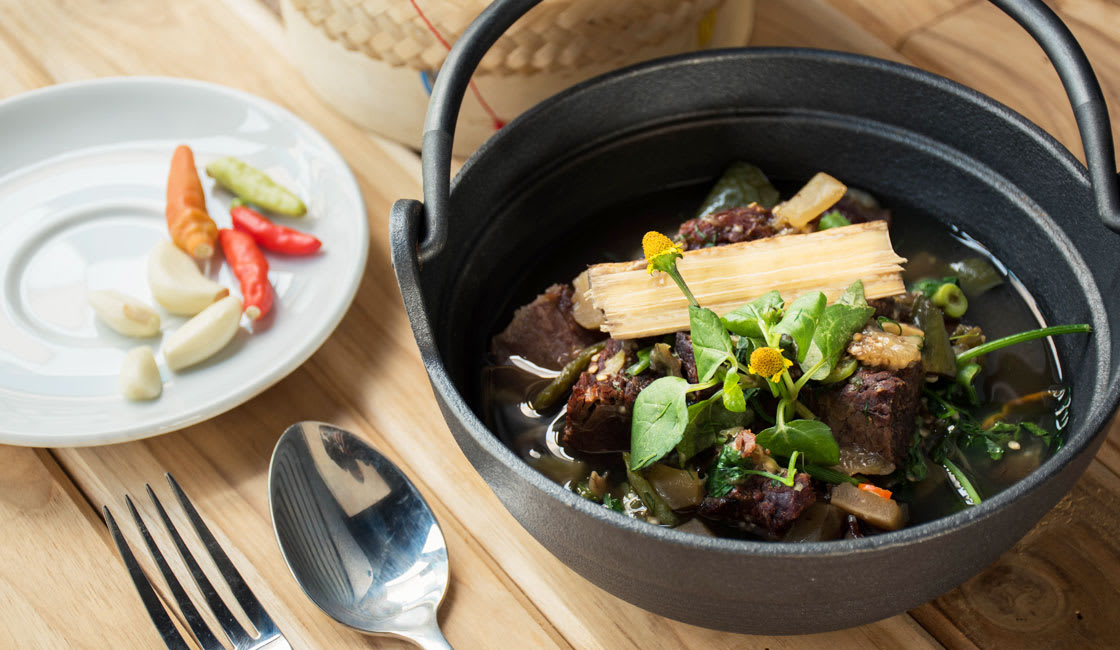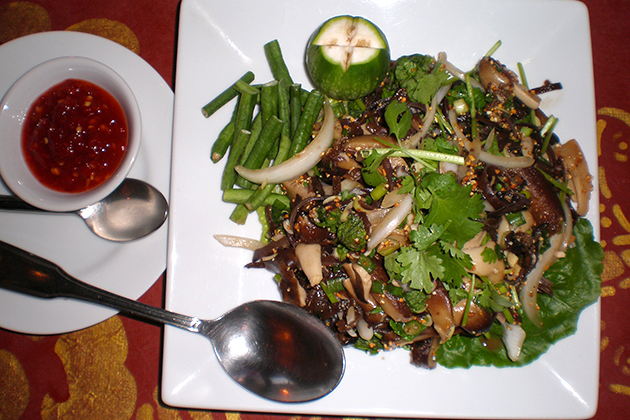If you’re a foodie looking to dive into the flavors of Southeast Asia, then you absolutely must try out some traditional Lao dishes. Laos has a unique culinary tradition that blends together influences from neighboring countries like Thailand and Vietnam with indigenous ingredients and cooking techniques. From sticky rice to savory stews, there’s no shortage of authentic dishes to sample in Laos. In this article, we’ll take a deep dive into the world of traditional Lao food, exploring some of the most popular dishes and ingredients, as well as the cultural and historical context that makes these foods so special.

Popular Traditional Lao Dishes:
Khao Niaw (Sticky Rice)
Khao Niaw is a staple of Lao cuisine. It’s a type of glutinous rice that sticks together and has a slightly sweet flavor. It’s served with almost every meal, often used to scoop up other dishes or rolled into small balls to dip into sauces.
Khao Niaw (Sticky Rice)

Sticky rice is also used to make snacks such as Khao Tom, a steamed rice cake that is seasoned with garlic and coriander and wrapped in a banana leaf.
.jpg)
Price: 5,000 – 10,000 Kip ($0.63 – $1.25)
Khao Jee (Baguettes)
Laos was under French colonial rule for many years, and one of the most significant legacies of this period is the country’s love for baguettes. You can find baguette sandwich stalls everywhere around the country.

The most common filling is pate made with pork liver, but you can add other fillings like ham, cheese, and vegetables.

Price: 5,000 – 10,000 Kip ($0.65 – $1.25)
Khao Piak Sen (Noodle Soup)
This classic Lao dish consists of rice noodles served in a rich broth made from chicken or pork bones. The broth is flavored with garlic, shallots, ginger, and fish sauce and garnished with sliced meat, bean sprouts, chopped herbs, and lime wedges. Every family has its recipe, and regional variations abound.

Price: 5,000 – 10,000 Kip ($0.65 – $1.25)
Khao Poon (Rice Vermicelli Soup)
Another noodle soup that is popular in Laos, Khao Poon uses rice vermicelli instead of the thicker noodles found in Khao Piak Sen.

The broth for this soup is made from coconut milk and fish paste, flavored with chili, lemongrass, and garlic, and garnished with herbs and vegetables.
Price: 10,000 – 12,000 Kip ($1,25 – $1,50)
Sao Oua (Sausages)
Lao sausages are typically made with pork, mixed with spices, and stuffed into casings made from pig intestines. The sausage is then grilled until crispy and served with sticky rice, dipping sauce, and fresh vegetables.

Price: 15,000 – 20,000 Kip ($1,70 – $2,50)
Tam Mak Hoong (Green Papaya Salad)
Tam Mak Hoong is a refreshing and spicy salad made from shredded green papaya, tomatoes, and carrots, dressed with lime juice, fish sauce, chilies, and sugar. Some versions include peanuts or dried shrimp. You’ll find it on almost every menu in Laos as a starter dish.

Price: 5,000 – 10,000 Kip ($0.65 – $1.25)
Or Lam (Lao Stew)
A hearty and savory stew, Or Lam is traditionally made with water buffalo meat, although beef or pork are often used today. The meat is cooked slowly with eggplant, pumpkin, and several types of herbs, including dill, basil, and coriander. The dish is usually served with sticky rice.

Price: 65,000 – 200,000 Kip ($8 – $25)
Ping Kai (Grilled Chicken)
A favorite street food in Laos, Ping Kai is marinated chicken that is grilled over charcoal. The chicken is usually served with sticky rice, chili dipping sauce, and vegetables.

Price: 10,000 – 12,000 Kip ($1,25 – $1,50)
Ingredients Used in Traditional Lao Cuisine
The flavors of Lao cuisine come from a wide range of ingredients, many of which are unique to the region. Common herbs and spices used in Lao cooking include lemongrass, galangal, kaffir lime leaves, coriander, dill, and mint. Fish sauce is also a staple ingredient in Lao cuisine. Sticky rice is another critical component of Lao food culture, used in both savory dishes and desserts.
Spices and Herbs Found in Traditional Lao Cooking
Lao cuisine uses a variety of fresh herbs and spices, including:
- Lemongrass: A fragrant grass with a citrusy flavor that is used in soups, marinades, and curries.
- Galangal: A root similar to ginger but with a more pungent flavor used in curries, soups, and stir-fries.
- Kaffir lime leaves: The leaves of the kaffir lime tree have a distinct flavor that is similar to lime zest. They are used in soups, stews, and curries.
- Dill: An herb with a slightly sweet taste used in soups and stews.
- Coriander: A versatile herb used in salads, soups, and curries.
- Mint: A refreshing herb with a cooling effect used in salads and dipping sauces.
Different Regional Variations of Traditional Lao Food
Like most countries, Laos has regional variations in its cuisine. The northern region, which is mountainous and cooler, relies more on freshwater fish, game meat, and vegetables such as mustard greens, bamboo shoots, and eggplant. In the south, which is warmer and more fertile, you’ll find more coconut milk-based dishes, seafood, and tropical fruits like mango and banana.
The cuisine of the central regions of Laos is the most diverse, with influences from both the north and south. Here, you’ll find dishes like Tam Mak Hoong and Or Lam, as well as spicy dips made from grilled eggplant or roasted tomatoes.
The Role of Sticky Rice in Lao Food Culture
Sticky rice is a staple food in Laos that plays a central role in Lao food culture. It’s used as a utensil, with diners using their hands to roll balls of sticky rice to pick up other dishes. It’s also used in desserts, snacks, and even beer.

Traditionally, sticky rice was cooked in bamboo baskets over an open fire, but today, electric rice cookers are more commonly used. Lao people take great pride in their sticky rice, and it’s often served at special occasions like weddings, funerals, and religious ceremonies.
Influence of Neighboring Countries on Traditional Lao Cuisine
Lao cuisine has been heavily influenced by neighboring countries like Thailand and Vietnam. You can see this influence in dishes like Khao Piak Sen, which is similar to Vietnamese Pho, and Tam Mak Hoong, which has some similarities to Thai Papaya Salad.
Additionally, French colonialism left its mark on Lao cuisine, as seen in dishes like Khao Jee (baguette sandwiches) and coffee, which is often served with sweetened condensed milk.
Traditional Lao Food Preparation Techniques
One of the unique things about Lao cuisine is the way that dishes are prepared. Many traditional Lao dishes require a significant amount of preparation and time to make, with many families passing down recipes from generation to generation. For example, a dish like Or Lam requires several hours of simmering to achieve the depth of flavor and tenderness of the meat.
Additionally, many Lao dishes use fermentation to develop complex flavors. For example, padaek is a fermented fish sauce used in many Lao dishes, including Tam Mak Hoong.
Lao Street Food Culture and Snacks
Street food is an essential part of Lao food culture, with vendors selling everything from grilled chicken to noodle soups on the streets of Laos. In addition to Ping Kai, other popular street foods include:
- Khao Jee Pa Te (pork and egg baguette sandwich)
- Khao Piak Khao (rice porridge)
- Sai Oua (grilled Lao sausage)
- Mok Pa (steamed fish in banana leaves)
Modern Innovations in Traditional Lao Food
While traditional Lao cuisine remains popular throughout Laos, chefs and restaurateurs are also experimenting with modern takes on classic dishes. For example, you might find fusion dishes that combine Lao ingredients with foreign techniques or ingredients like foie gras.

Another trend is the use of high-quality, locally sourced ingredients, such as organic vegetables and free-range meats. This focus on quality and sustainability is helping to elevate the profile of Lao cuisine both at home and abroad.
Conclusion
Traditional Lao cuisine offers a unique and flavorful experience that blends together a rich history and diverse cultural influences. Whether you’re sampling sticky rice or digging into a steaming bowl of noodle soup, Lao dishes are sure to tantalize your taste buds. So next time you’re in Laos, don’t hesitate to try out some of these delicious and authentic dishes for yourself!


















